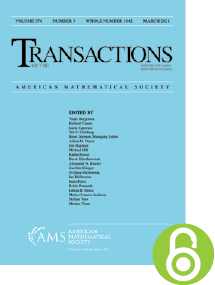The Rahman polynomials and the Lie algebra $\mathfrak {sl}_3(\mathbb {C})$
HTML articles powered by AMS MathViewer
- by Plamen Iliev and Paul Terwilliger PDF
- Trans. Amer. Math. Soc. 364 (2012), 4225-4238 Request permission
Abstract:
We interpret the Rahman polynomials in terms of the Lie algebra $\mathfrak {sl}_3(\mathbb C)$. Using the parameters of the polynomials we define two Cartan subalgebras for $\mathfrak {sl}_3(\mathbb {C})$, denoted $H$ and $\tilde H$. We display an antiautomorphism $\dagger$ of $\mathfrak {sl}_3(\mathbb {C})$ that fixes each element of $H$ and each element of $\tilde H$. We consider a certain finite-dimensional irreducible $\mathfrak {sl}_3(\mathbb {C})$-module $V$ consisting of homogeneous polynomials in three variables. We display a nondegenerate symmetric bilinear form $\langle , \rangle$ on $V$ such that $\langle \beta \xi ,\zeta \rangle = \langle \xi ,\beta ^\dagger \zeta \rangle$ for all $\beta \in \mathfrak {sl}_3(\mathbb {C})$ and $\xi ,\zeta \in V$. We display two bases for $V$; one diagonalizes $H$ and the other diagonalizes $\tilde H$. Both bases are orthogonal with respect to $\langle , \rangle$. We show that when $\langle , \rangle$ is applied to a vector in each basis, the result is a trivial factor times a Rahman polynomial evaluated at an appropriate argument. Thus for both transition matrices between the bases each entry is described by a Rahman polynomial. From these results we recover the previously known orthogonality relation for the Rahman polynomials. We also obtain two seven-term recurrence relations satisfied by the Rahman polynomials, along with the corresponding relations satisfied by the dual polynomials. These recurrence relations show that the Rahman polynomials are bispectral. In our theory the roles of $H$ and $\tilde H$ are interchangable, and for us this explains the duality and bispectrality of the Rahman polynomials. We view the action of $H$ and $\tilde H$ on $V$ as a rank 2 generalization of a Leonard pair.References
- R. W. Carter, Lie algebras of finite and affine type, Cambridge Studies in Advanced Mathematics, vol. 96, Cambridge University Press, Cambridge, 2005. MR 2188930, DOI 10.1017/CBO9780511614910
- J. J. Duistermaat and F. A. Grünbaum, Differential equations in the spectral parameter, Comm. Math. Phys. 103 (1986), no. 2, 177–240. MR 826863
- Jeffrey S. Geronimo and Plamen Iliev, Bispectrality of multivariable Racah-Wilson polynomials, Constr. Approx. 31 (2010), no. 3, 417–457. MR 2608419, DOI 10.1007/s00365-009-9045-3
- F. Alberto Grünbaum, The Rahman polynomials are bispectral, SIGMA Symmetry Integrability Geom. Methods Appl. 3 (2007), Paper 065, 11. MR 2322792, DOI 10.3842/SIGMA.2007.065
- Michael R. Hoare and Mizan Rahman, A probabilistic origin for a new class of bivariate polynomials, SIGMA Symmetry Integrability Geom. Methods Appl. 4 (2008), Paper 089, 18. MR 2470507, DOI 10.3842/SIGMA.2008.089
- Plamen Iliev, Bispectral commuting difference operators for multivariable Askey-Wilson polynomials, Trans. Amer. Math. Soc. 363 (2011), no. 3, 1577–1598. MR 2737278, DOI 10.1090/S0002-9947-2010-05183-9
- Tatsuro Ito, Kazumasa Nomura, and Paul Terwilliger, A classification of sharp tridiagonal pairs, Linear Algebra Appl. 435 (2011), no. 8, 1857–1884. MR 2810633, DOI 10.1016/j.laa.2011.03.032
- Tatsuro Ito, Kenichiro Tanabe, and Paul Terwilliger, Some algebra related to $P$- and $Q$-polynomial association schemes, Codes and association schemes (Piscataway, NJ, 1999) DIMACS Ser. Discrete Math. Theoret. Comput. Sci., vol. 56, Amer. Math. Soc., Providence, RI, 2001, pp. 167–192. MR 1816397, DOI 10.1090/dimacs/056/14
- Jens Carsten Jantzen, Lectures on quantum groups, Graduate Studies in Mathematics, vol. 6, American Mathematical Society, Providence, RI, 1996. MR 1359532, DOI 10.1090/gsm/006
- R. Koekoek and R. F. Swarttouw. The Askey scheme of hypergeometric orthogonal polyomials and its $q$-analog, report 98-17, Delft University of Technology, The Netherlands, 1998. Available at http://fa.its.tudelft.nl/$\sim$koekoek/askey.html
- Hiroshi Mizukawa and Hajime Tanaka, $(n+1,m+1)$-hypergeometric functions associated to character algebras, Proc. Amer. Math. Soc. 132 (2004), no. 9, 2613–2618. MR 2054786, DOI 10.1090/S0002-9939-04-07399-X
- Paul Terwilliger, Two linear transformations each tridiagonal with respect to an eigenbasis of the other, Linear Algebra Appl. 330 (2001), no. 1-3, 149–203. MR 1826654, DOI 10.1016/S0024-3795(01)00242-7
- Paul Terwilliger, An algebraic approach to the Askey scheme of orthogonal polynomials, Orthogonal polynomials and special functions, Lecture Notes in Math., vol. 1883, Springer, Berlin, 2006, pp. 255–330. MR 2243532, DOI 10.1007/978-3-540-36716-1_{6}
Additional Information
- Plamen Iliev
- Affiliation: School of Mathematics, Georgia Institute of Technology, Atlanta, Georgia 30332-0160
- MR Author ID: 629581
- Email: iliev@math.gatech.edu
- Paul Terwilliger
- Affiliation: Department of Mathematics, University of Wisconsin, 480 Lincoln Drive, Madison, Wisconsin 53706-1388
- Email: terwilli@math.wisc.edu
- Received by editor(s): June 24, 2010
- Received by editor(s) in revised form: October 31, 2010
- Published electronically: March 20, 2012
- Additional Notes: The first author was supported in part by NSF grant DMS-0901092.
- © Copyright 2012
American Mathematical Society
The copyright for this article reverts to public domain 28 years after publication. - Journal: Trans. Amer. Math. Soc. 364 (2012), 4225-4238
- MSC (2010): Primary 33C52; Secondary 17B10, 33C45, 33D45
- DOI: https://doi.org/10.1090/S0002-9947-2012-05495-X
- MathSciNet review: 2912452


